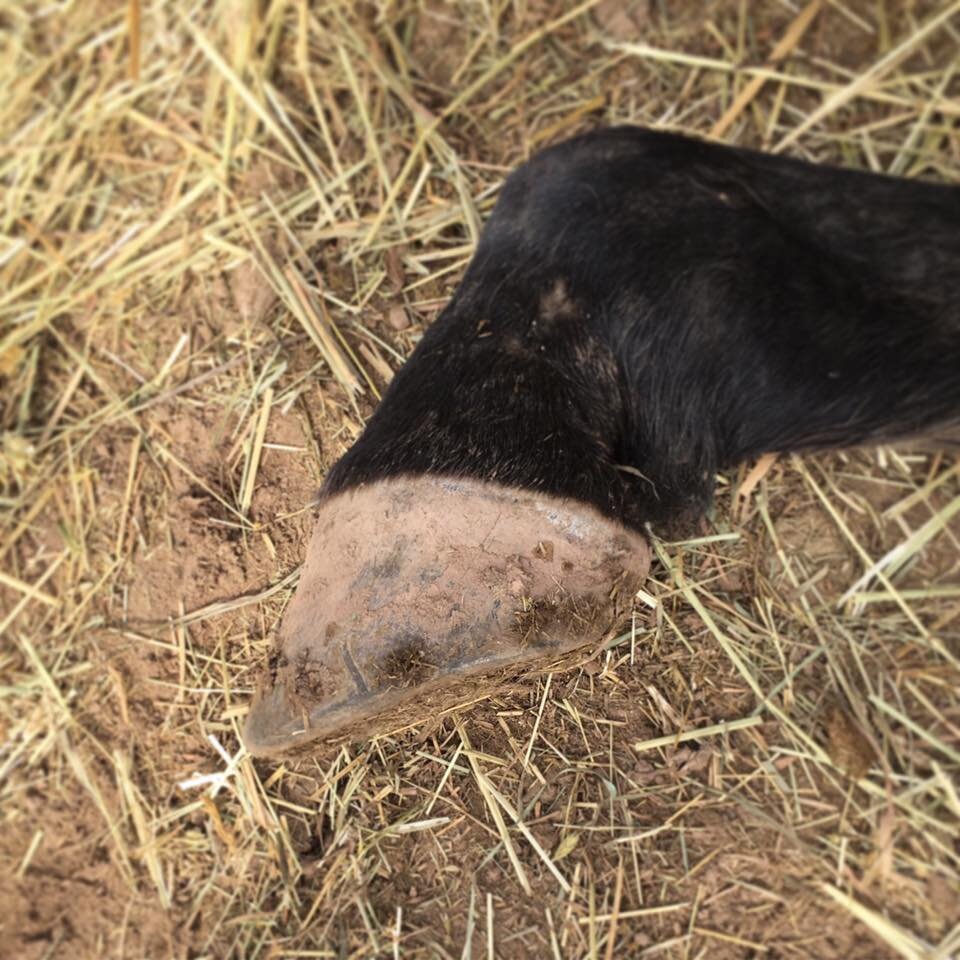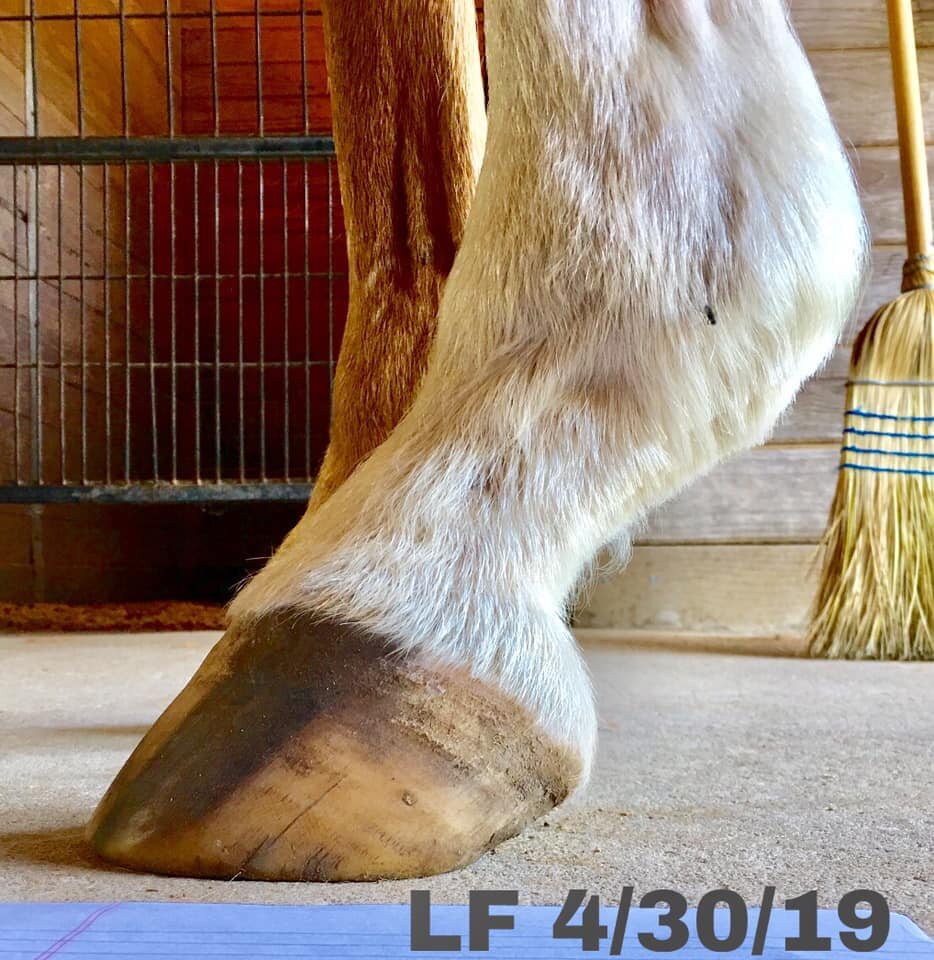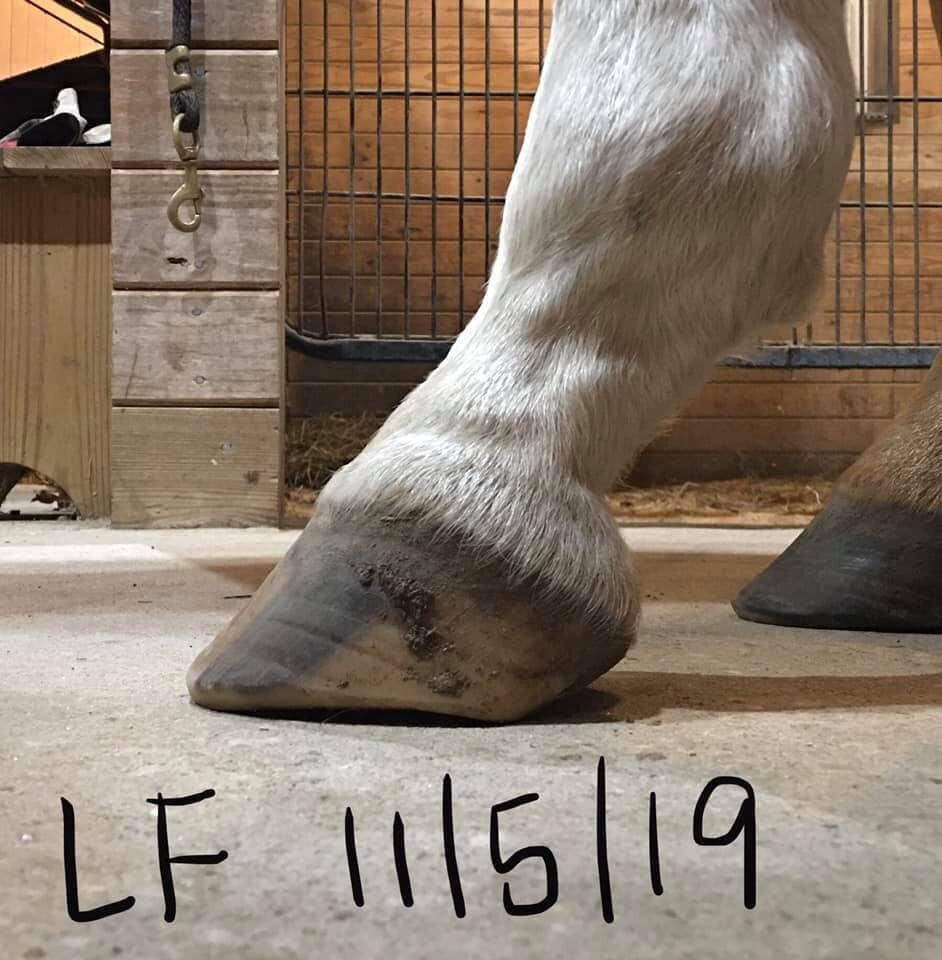Apex creates a hoof that's sound even on harsh terrain.
Awareness
It only takes a moment to slow down and be more aware. More aware to connect the pieces. To think, why if this is done, this happens. Awareness of how the hoof effects your ride. It doesn’t cost you a dime to be aware. Awareness can be visual, or that inner voice you better listen to.
I see so many top trainers taking years, trying to “correct a horse”, when the root of the issues, are the hooves.
I see body workers trying to fix sore muscles and skeletal wear and tear. They have no awareness how it starts in the hooves. They will diagnose “kissing spines” in an under run hoof, that can’t mechanically support the spine. It’s a cookie cutter approach and they are not aware of the bigger picture.
I see farriers cutting perfect lines in frogs, mapping hooves and measuring. They are totally unaware how their trim effects the rest of the horse. They create joint, tendon, ligament and behavior issues. They obsess over the bottom of the hoof and do not take note of the entire horse. They argue over trim theories without being aware of what a truly sound natural hoof is. They aren’t aware of one, even in front of their nose. Awareness creates an organic trim with guidelines and not rules and measurements. That is just another cookie cutter approach.
I see owners not aware of the hardships they put on their horses. They then wonder why the horse breaks down. From bad hooves, over worked bodies, bad training, and too much training.
One becomes more aware when you educate yourself, but the root is in empathy. Put yourself in your horses’s life. Are you at the gym hours a day? Then go home and sit alone, in a tiny room . With very little to eat? Away from family and friends? Then expected to do this without pay or rest? How long would you hold up? How long before you had a mental or physical breakdown? Would you then be labeled naught?
Being aware, you see and think about everything. It’s hard to see everything, it can be overwhelming. But this awareness gives you the answers you seek. Don’t rely on others to save you. Be aware of your horse’s needs. Don’t follow the crowd. Be aware of every movement, body language, and listen to them. They will then open up to you and trust you. They will communicate with you more and come to you for comfort. This is the special bond everyone seeks with their horse.
If you want to know everything about a human’s soul and their self- development, watch how they are around their horses. Look at the health and happiness of the horse. Mentally and physically. This is why true horseman take pride in their horses. They are aware it ‘s a mirror of themselves. Horsemanship are all about self awareness , and your awareness of the horse.
Key To Healthy Hooves
The main mission of the trim is to remove stress off the lamina. The lamina is effected by over trimming, shoes, bad diet, and over grown walls. We are only resetting the hoof to it’s natural shape of the hoof with Apex trim. Nature knows best and not man-made trim theories, and products put on the horse. Man-made shoes, boots, devises, do not heal the lamina or the hoof. If you get out of the way and know how to just excel the natural rehab of the hoof, rehab is very easy. This is why wild horses don’t need farriers. The same can be with domesticated horses ,once you rehab all the previous human error that was put on the hoof.
Read moreThe True Hoof
Apex E-book is available
$20 fee
This goes over the basics of Apex. It doesn’t replace the one on one online instruction I give. But it’s a starting point to understanding the trim.
If interested there is a link in the menu to my e-books.
Self-Trimming Hooves
Certain types of footing and weather create more self trimming on the hooves. The trim must be changed based on this.
A hoof navigating deep mud will round the outer walls on their own.
The hoof can not have a normal trim or the hoof will end up over trimmed.
will see heel loss.
Learning to scale back trim frequency, to the needs of the hoof, is vital.
Looking ahead in the forecast. If you see several weeks of warm weather and rain this needs to be taken into account.
Just the same if your horse is navigating over frozen ruts.
Most horses will also grow less hoof in the winter. They are standing around more and eating hay instead of pasture. Less hoof mechanism, slower metabolism, and more fiber dense food source, slows the growth. But winter terrain and weather self trim a hoof more than soft lush pasture.
So, always check the weather, note the terrain, adjust trim schedules to the need of the hoof. Or you will end up with very little hoof left ,by spring time.
Healing Cracks
Cracks are healed with the Apex Trim Method. They are not filled away. We never use outer wall intrusion techniques. We completely heal the wall, and attachment to the lamina. The correct trim prevents issues. Old ways of trimming try to band aid, the break down of the hoof. They never fully heal the hoof.
The sole is a bowl. It's impossible for it to function as nature intended, with a flat piece of metal nailed on it.
The Nature of the hoof is removed by human error. Learn to restore the true nature of your hooves.
Very rarely you see a true club.
Up-righting Heels and Walls
This is the same horse.
First picture was an over trimmed hoof in the heel. The outer wall has lost vertical alignment. Outer wall should reflect the same angle as the lamina that connects it.
Second picture is a hoof that is aligned to internal structures. The heels align the bone column. This allows proper blood flow through the navicular bone. The stress is removed from the ligaments and tendons.
All Horses Can Rehab
The trimmer that blames the breed, age, and genetics of the horse, to why they don’t rehab. This is a trimmer that doesn’t know how to rehab. Their trim techniques prevent the rehab. If you apply the same trim over and over and not obtain rehab, the trim is in need of rehab. All hooves are fixable.
Why Does My Horse Have Abscesses in the Mud
A horse that spends several days in mud, rain, or snow can have issues with their soles. They become too soft. When you have a soles that become too soft, it’s now softer than the bar. Anywhere you have bar that is sitting on the sole, such as overlaid bars or bars around the frog, this harder bar material bruises the softer sole. The horse can become tender over rocks and pavement as well. They can bruise and abscess.
The softening of the outer wall and soles can also release old bruising and trauma. Even if the trauma was months ago. As the soles soften the abscess tracks work their through the soles, out the softened coronary band and heel bulbs. The softer hooves the horse will feel the trauma they couldn’t feel when the sole was more firm.
If you have a long spell of wet weather and footing, and then it dries out, you can have a crippled horse. But the horse isn’t truly unsound. The soles are just soft. The key to keeping a horse sound in all weather and footing is just to plan ahead.
Realize that soundness comes from the firmness in the soles. This is why horses in dry desert areas can hold up to hoof stress, the soles are like rocks. These hooves become so hard they don’t exfoliate enough. This can cause flares and under run heels. The key is making sure the hooves aren’t to dry, to soft, but just right. The hooves change with the weather. They are slaves terrain.
Here are some steps you can take to help the soles during changes in weather of prolonged dry or wet periods.
If you foresee long periods of rain, mud, snow, you can apply hoof hardener to the soles.
If the horse is in standing water or mud harden the outer wall also. (keretex is a good product)
make sure there is no extended bar material on the soles.
If you had long periods of mud ,think before you ride over areas that aren’t mud. Firm your soles. The sole changes with the terrain and weather. You can’t expect soft soles to be sound on rocks and hard ground unless you firm them up. A day or so before change of footing harden your soles to prepare them.
Hooves that are in excessive dry climates such as sand and dirt, can get very dry. They are rock hard, knives can’t even lower the bars. You start stressing the lamina. False sole pushes on the outer walls. Outer walls are weight bearing.
These hooves can be soaked in water. Small fragments of carpet can be soaked for them to stand on.
So with a little planning, hooves can remain sound . Through all terrains and weather. Check your hooves weekly so you don’t get big surprises when hooves are checked.
Anyone Can Learn To Trim
The large majority of my Certified Trimmers never held a rasp, before they started, with online instruction. What they all have in common is endless hoof issues, struggling with the high cost of hoof care, upset seeing their horses struggle. They keep getting one trim after another and never get on top of the underlying issues with the hoof.
learning to trim saves time and money
the hoof is trimmed when needed
it’s not a farrier’s schedule
distortions are able to be fixed in small weekly or bi-weekly trims
you prevent issues and keep your horse sound all the time
there is no soreness after a large trim
you become an advocate for your horse
Apex trimmers are covering the globe. Many trimmers have gained a new career trimming and rehabbing hooves. It’s a rewarding and new relationship with your horse.
Apex Trim Online Instruction
This is an example what can be achieved with Apex Trim. Method. This trimmer is a certified Apex trimmer located in Ohio, USA. She worked online through mark-ups. She hosted and participated in my Ohio clinic. She also studied one on one with me, at my farm. She was able to learn on sound healthy horses. This trained her eye to what a true sound hoof looks like. This has created a very accurate trimmer with a lot of talent.
This is a new horse for her. This is just one trim on this horse. I marked up for her online what to trim. You can see how the balance was reset in the hoof. The stress lines will grow out. When you trim correctly you heal the stress on the walls, tendons and ligaments in the leg. You can achieve in just a few trims that other trims methods can’t achieve.
Correcting The Pastern Angle
The Apex Trim Method, rebuilds the support in the heel. This foundation of support is vital for the proper bone alignment of the leg, reduces stress off the tendons and ligaments. You can see the more upright and supportive pastern in this before and after picture.
Removal of the Outer Wall
When the trimmer pulls the hoof forward, and files the outer wall, they are removing support out of the hoof.
The trim should never try to hide a flare by removing outer wall
Instead the flare is healed and fully removed from trimming from the bottom of the hoof. The new tight lamina connection grows down from the top and the flares grow out.
Neglect and bad trims cause the stress on the lamina that causes the flare. Correct these issues and you heal the hoof internally and heal the flare.
Outer wall protects the softer internal structures. Too much removal you created too much give in the hoof. Too much flexion and stress, and cause mechanical laminitis.
Old outed theories of trim, shape a hoof to a shoe. Instead the hoof should function on it’s own to gain soundness over varied terrains. Outer wall thickness is key to soundness.
Before and After VIdeo
This horse struggled with 2 years of lameness. He started out in metal shoes, out of shoes, then plastic shoes, then barefoot. He went through 4 different farriers and still abscessing and lame.
His owner found me online and signed up for mark ups. I taught her how to trim. I showed her why he was lame and how we would resolve it. Like most horses he was over trimmed in the heels. When you lower the heel to the widest part of the frog, you must then remove bar height and sole depth. This is why these horses just keep abscessing.
She is now a certified trimmer and one of my best trimmers.
Many horses are told to be put down, retired, or they would never be sound by Vets.
I have hundreds of success stories. Ongoing lameness is the main reason clients reach out to me. I regain soundness in the horse and give them their life back.
This trail horse had ongoing hind end lameness. He was on pain medications and told to retire him. He is off all pain medications and getting his life back. He’s not even fully rehabbed yet.
Chronic over trimming of the horse effects the entire body. When the vet and farrier tell you it can’t be fixed it”s because they caused the issue. The vet knows many times how to fix a hoof,but can’t figure out why the farrier isn’t getting results wanted. It’s because the farrier keeps applying the same trim. The trim is the issue. Those that caused the problem can’t see how to fix it.
This owner learned to trim online with me. He had over trimmed heels, lacked sole depth and flares. He’s coming along enough in the rehab to now be pain free and move freely. You can find many videos like this in my FB Apex Success Stories public group.



















